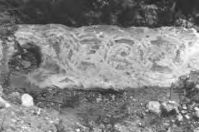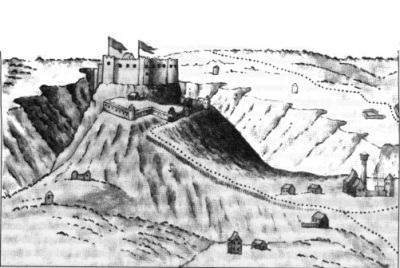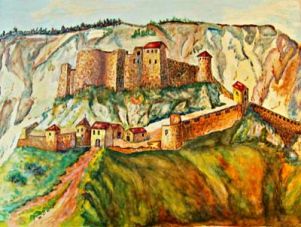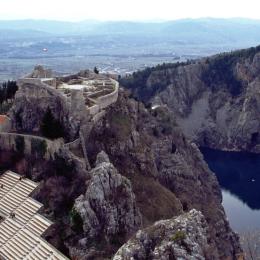| |
|||||||||||
| |
|||||||||||
| |
|||||||||||
|
During the Turkish rule, starting in year
1493, the fortress was
renovated and served as an important military post. The fortress commander
was called Dizdar. In later years of Turkish rule Imotski
captain lived in the fortress. There were
few houses outside Topana, that was how the fortress was called at the time,
walls. In one of them lived Kadija or Turkish judge, who was
immortalized in a famous Croatian ballad
Hasanaginica. Topana
got is name from Turkish word "tophana" - house for keeping arms.
The time came to free Imotski from Turkish yoke after 60,000 Turks led
by Mustaj-pasha Čelić failed to capture Sinj in 1715 on August 15, the
day that is celebrated as "Velika Gospa" or "Large Lady of the Angels" holiday in Sinj ever since, attracting
many pilgrims from whole Dalmatia. Venetians were helped by
Imotski Franciscans, friars Stipan Vrljić and Lovro
Sitović who sheltered 800 Catholics from Imotski county to
Omiš during there last escape from Imotski. Rich
merchant duke Šoić from Mostar, who has escaped from there promised to
replace all lost canons in fight for Imotski.
The siege started on July 27 with the canon
barrage on the fortress
with mixed results. Two gunpowder silos exploded, reducing the
fighting prowess of the Turks. Even after losing 27 soldiers the
fortress defenders were not discouraged, still fighting
valiantly.
Imotski and Sinj fighters sensing that their time has come to
overcome
the oppressors led a charge to break the lower walls, but the main
inner walls were too high and unconquerable for the attackers. The only
option to defeat the Turks was to mine the inner walls. That
proved to not be necessary since the Turks started negotiating their surround upon
earning of the mined inner walls. The negotiations were completed on
August
1 with Venetians accepting the surround terms. All the provisions were
left in the fortress and the remaining soldiers received free
passage. Most of the Turks went to Mostar and Ljubuški,
while 37 of them converted to Christianity and stayed in Imotski.
On August 2, Imotski was free of Turks. August 2 become Imotski holiday, "Gospa od
Anđela"
or "Lady of Angels" when many people come back to Imotski to have a
celebration that starts on August 1 in the evening and lasts till the sunrise
the following day. The most important persons in these operations were general Emo and serzent-major of artillery Rizzo, friars Stipan Vrljić and Lovro Sitović, duke Mate Šoić, and Serdar Stjepan Vučković. They were all rewarded with abandoned Turkish lands and all of them, but the friars received army advancements. After the defeat of the Turks the Venetians assumed the power and have installed their own administration. The fortress continued to have a military importance and had a military commander living there. The first colonel of Imotski became duke Mate Šoić.
The Venetians used the fortress during their stay in
Dalmatia, but the strategic importance of the fortress started to
diminish during the brief two periods of the first Austrian
occupation and French occupation. Three years after the second
Austrian occupation in 1816 the fortress was abandoned officially
and the chaplain was relieved from his duty. After that year
the fortress was neglected and slowly the nature and the Bazana home
builders had caused the walls to crumble. Finally in 1974 the
governing people have become aware what historic monument they have
and started preservation and partial restoration of the fortress
that was completed in 1983.
The bottom two photos show the extent of the restoration. The
fortress is in a good shape, open for visiting year around. It
offers spectacular views in all directions. In the late
nineteen seventies soccer stadium works started that took more than
ten years to fully complete, giving Imotski very unique facility.
Within the outer fortress walls there is a "Lady of the Angels"
church, which building has been started by the Venetians the
following months after the victory. It was opened in 1720 commemorating the victory
against the Turks. Friar Stjepan Vrljić become the first
fortress vicar (Župnik). |
|||||||||||
 Imotski fortress
Imotski fortress



